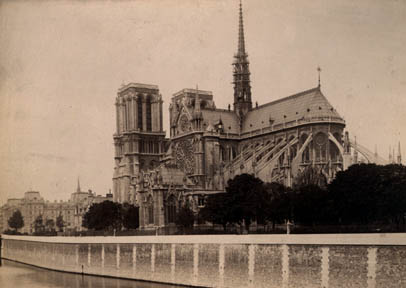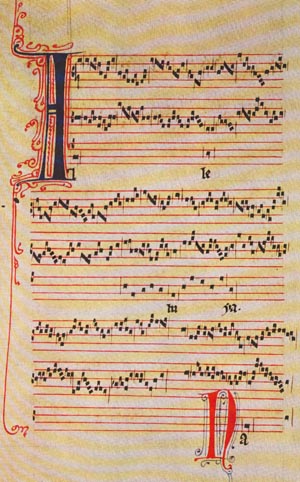

 |
It is likely that the Organum version of Kyrie Cuntipotens Genitor found at Compostela Cathedral was brought there by pilgrims from the cathedral at Notre Dame. Notre Dame cathedral in Paris (the precursor to the famed current-day cathedral) was a major stop on the Pilgrimage. The western portal of the Cathedral was known as Saint James' door and the road that led from it the Rue St. Jacques. Organum performed at Notre Dame took the continent by storm and was disseminated via the pilgrimage route and among scholars who had made their home at the cathedral, an extremely important center of scholarship. In the beginning of the millenium, scholars such as Abelard lived and learned in the closed cloister surrounding the cathedral. After a series of disputes between the institution and its neighbors, learning shifted to the Left Bank of the Seine. An English chronicler known to history as Anonymous IV (his was the fourth anonymous account published in a 19th century collection of medieval texts about music) provides one of the earliest first-hand accounts of the music heard at Notre Dame. He wrote: Master Leoninus was generally known as the best composer of organum, who made the great book (Magnus Liber) of organa for Mass use until the time of the great Perotinus, who shortened it and substituted a great many better clausulae, becuase he was the best composer of discant and better than Leoninus. Moreover this same Master Perotinus wrote excellent compositions for four voices, such as Viderunt and Sederunt, replete with artful musical turns and figures, as well as a considerable number of very famous pieces for three voices, such as the Alleluias Posui adiutorium, [Alleluia] Nativitas, etc. Besides, he also composed conductus, such as Dum sigillum summi patris, and monophonic conductus, e.g. Beata viscera, and lots more. The book, or rather books, of Master Perotinus have remained in use in the choir of the Church of Our Blessed Virgin in Paris until the present day. Perotin ("little Pierre") was responsible for this great organum. He is believed to have flourished around the turn of the thirteenth century. The institutional church's view of organum was ambivalent. Some, such as John of Salisbury, viewed it as the work of the devil, writing: "they can more easily occasion titillation between the legs than a sense of devotion in the brain." Others like Bishop Odo, sensed its utility and beauty. |
| A.. | 0:00 | Group of soloists establish mode and consonant intervals. Central pitch, then octave, then fifth. |
| A - | 0:15 | Soloists begin 3-voice organum. First note of chant held as a long drone. |
| le - | 0:30 | Second note of chant is elaborated, organum continues. |
| le(continued) - lu | 1:08 | Motion of the drone is quicker. |
| -ia | 1:34 | Return to longer notes in the drone. |
| -ia (continued) | 2:18 | Cadence |
| Alleluia | 2:23 | Chant is sung monophonically |
| Na- | 2:55 | Establishement of mode and consonance again. |
| Na - (continued)-ti-vitas gloriose virginis Marie | 3:05 | Alleluia verse is sung in organum |
| ex semine | 6:00 | Chant line (tenor) is begun to be rhythmicized also. |
| Abrahe orta de tribu | 7:08 | Return to long drones |
| Iuda. | 9:10 | Motion of the drone is quicker. |
| -da. | 10:14 | Final cadence |
| Clara ex stripe David. Alleluia | 10:41 | Remainder of chant sung monophonically. |
Alleluia Nativitas gloriose virginis Marie ex semine Abrahe orta de tribu Juda clara ex stripe David. |
O glorious nativity of the Virgin Mary, born of the seed of Abraham of the tribe of shining Judea, out of the stock of David |